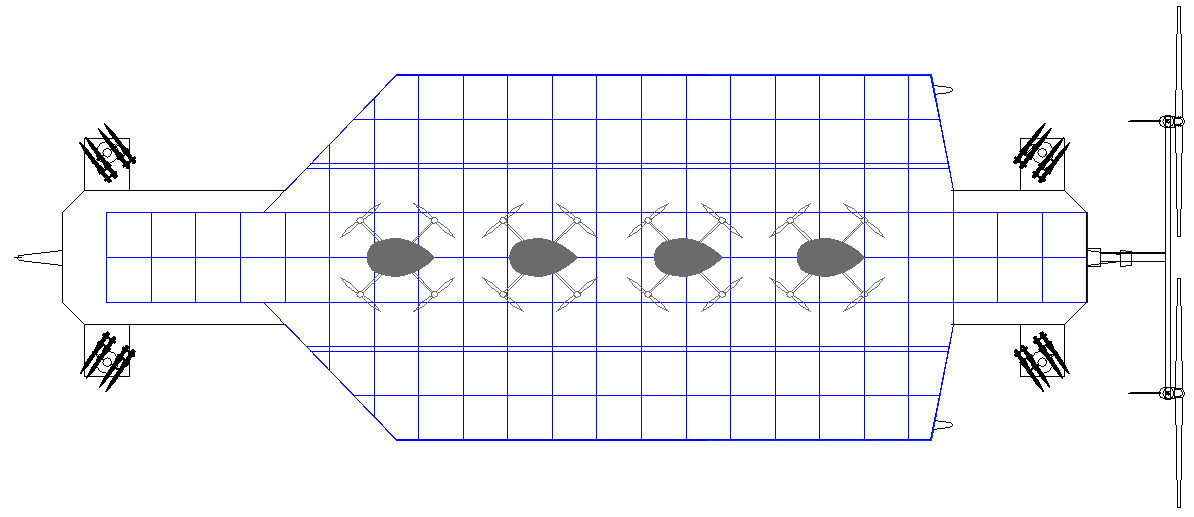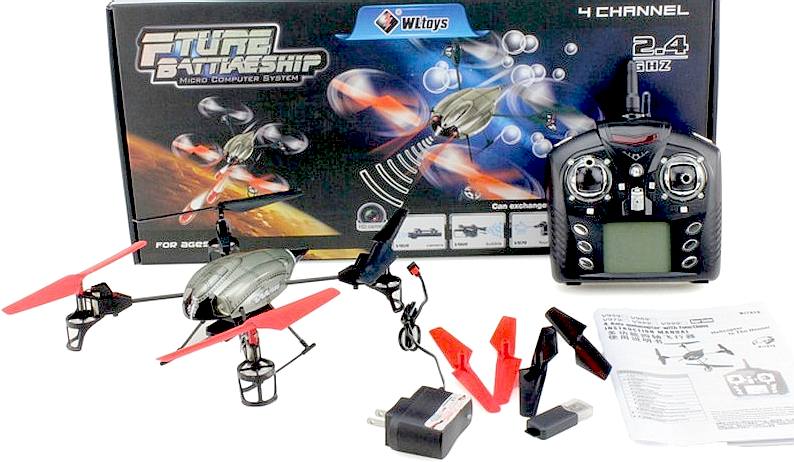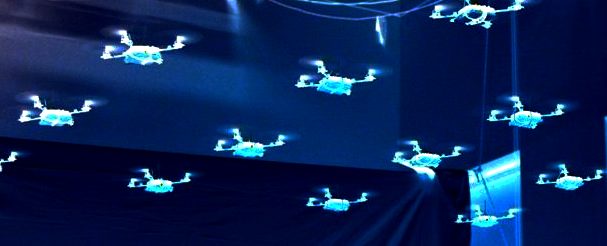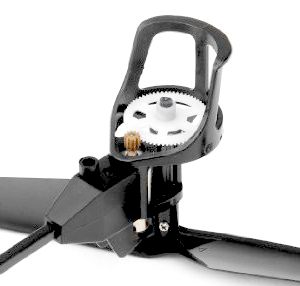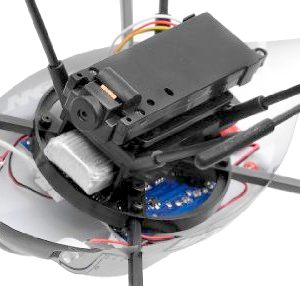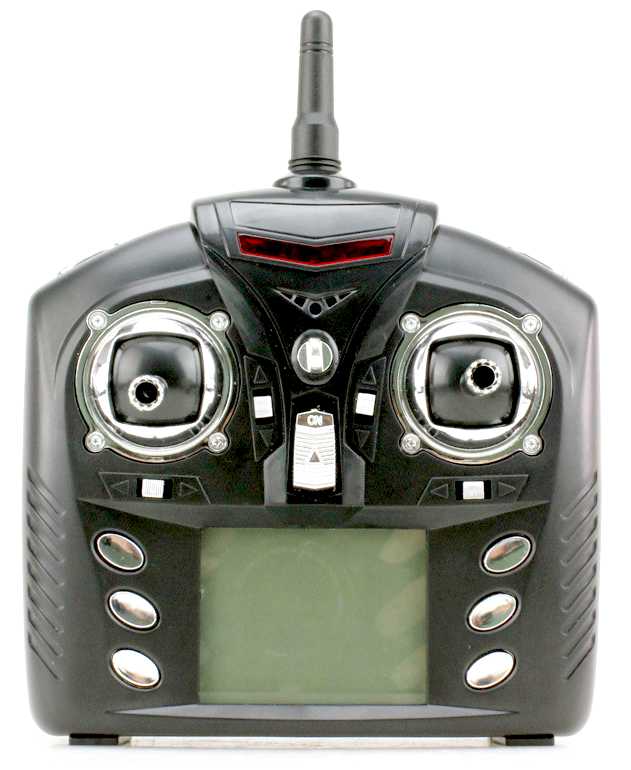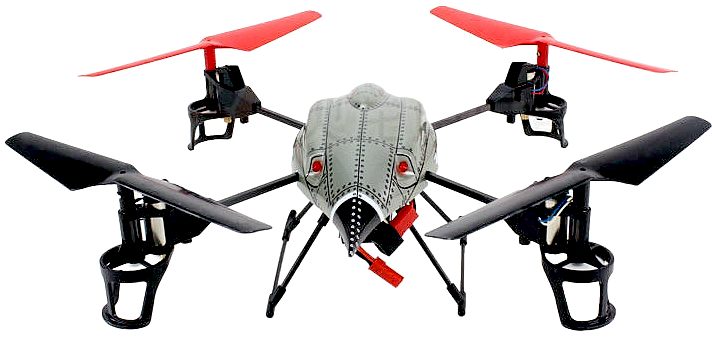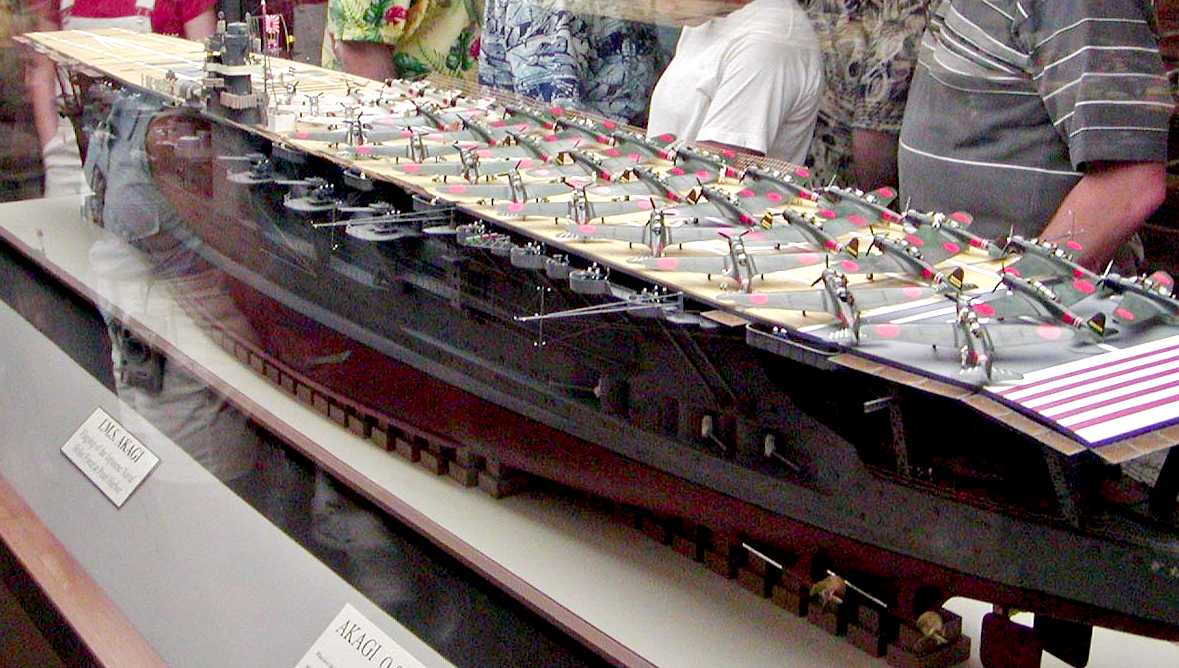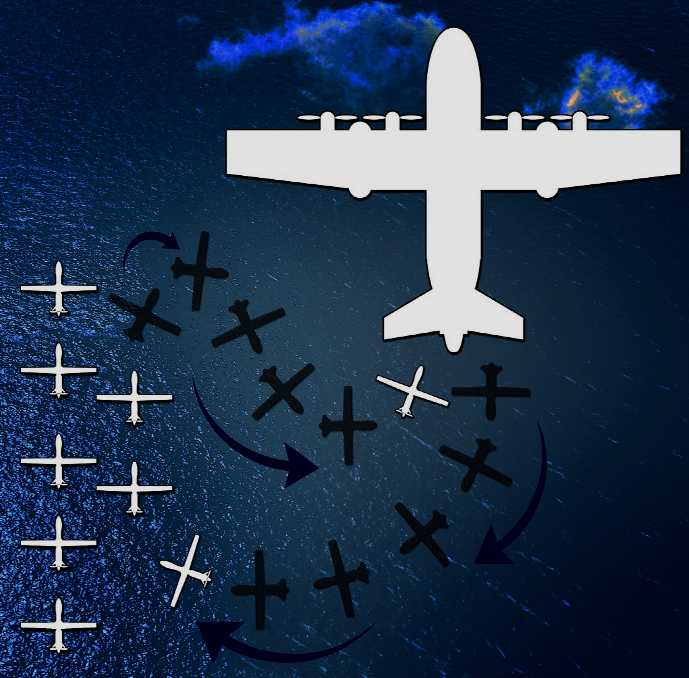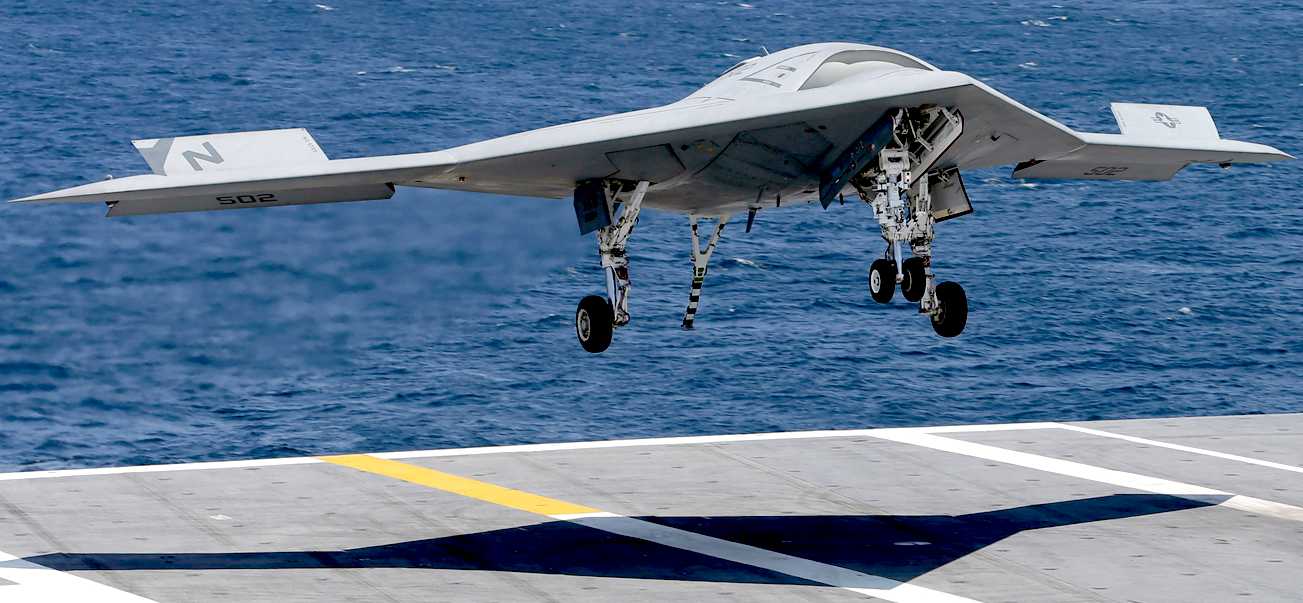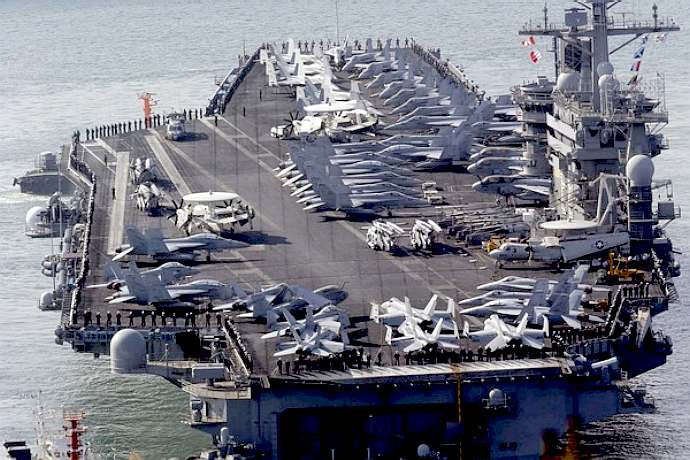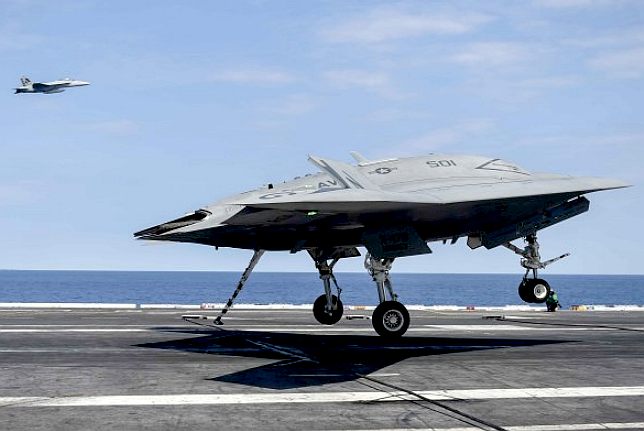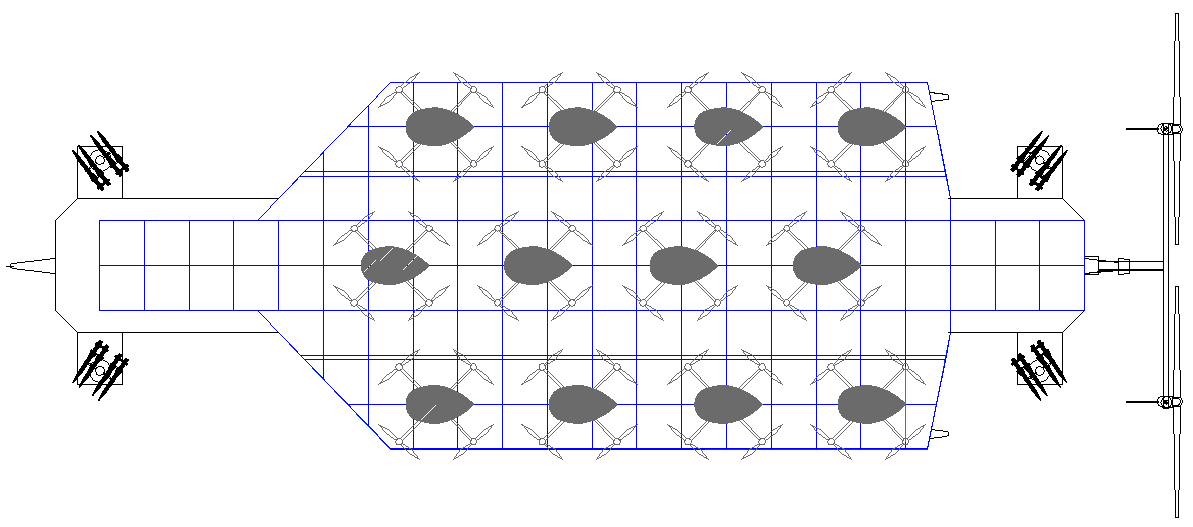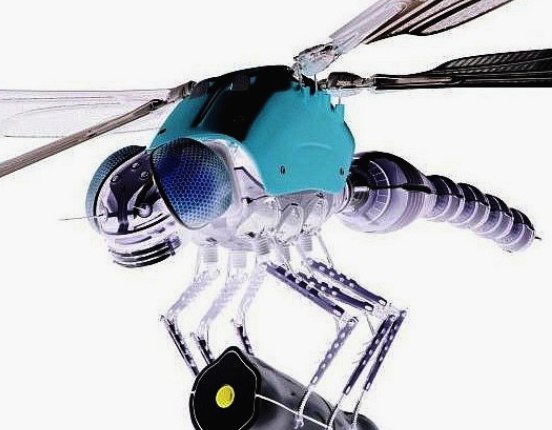|
DRONE AIRCRAFT CARRIER - QUADCOPTER SQUADRON
|
|||
|
The world's first ever solar powered aircraft carrier, showing a squadron of 4 4.7m (to scale) drone quadcopters. This ship could easily carry 12 birds. This is also, probably, the world's smallest ever aircraft carrier and the first unmanned aircraft carrier - so, a real game changer. A 1/20th scale model of this vessel will take to the water in 2015 for some naval wargaming fun. Will it ever happen in real life? Almost certainly. Why? Because it's the cheapest and safest way of asserting a military presence. You don't need to train and feed a crew at sea, whose lives are on the line, just train a small ground-crew to monitor situations and take the appropriate action as and when required. It's a bit like shopping online and going to the shops. Going to the shops is healthier and a day out, but shopping online gives you more choice - for the same goods - at lower prices without leaving GHQ.
Please note that the above design is a small scale model designed for wargaming by way of an a hobby that may benefit us in the design of larger ocean going vessels. BMS is a company dedicated to the sustainable development of mankind. BMS has no intention of bidding for military contracts or otherwise seeking to get involved in the arms industry - other than to suggest that all navies think about reducing the carbon footprint.
WHAT IS AN AIRCRAFT CARRIER ?
An aircraft carrier is by definition a vessel that carries a squadron of airborne craft. The Scorpion destroyer may carry several quadcopter drones to become a mini aircraft carrier. The usefulness of having a squadron of drone quadcopters onboard is determined by the function of the quads and their equipment, or specification. Where four quadcopters are shown in the CAD drawing above, you can see that there is deck space to carry 12 helios with ease, and more if a diagonal layout is adopted as per the Japanese Navy's IJN Akagi aircraft carrier from WW2. (see below).
Recon and surveillance capability is thus added to a drone fleet, and of course the ability to streak ahead to a target submarine (that may be getting away) and drop a homing torpedo. Where the full sized drones would be IC powered, the full size carrier would also have IC power for sprint operations of 30-35 knots. That is another advantage of this design, the low drag hull. See the patent description as to how a vessel like this avoids wave drag and operates with minimum skin friction, by keeping the wetted area down.
With Russia, China and Korea all extending nuclear submarine capacity, the race is on for a solution to the massive increase in operational costs that a return to a cold war situation will require. Our objective is to ensure peace, by making it near impossible for a potential aggressor to wipe us and our friendlies out.
With that thought in mind, why would either party wish to harm their international trade partners? You would think that the new 'global market' and other global issues, mainly the struggle closed loop sustainability, would put a stop to genuine aggressive negativity - where we admire the Chinese, Russians, (all other cultures), and they admire our creative output.
This is what you get in the box. Not bad!
FIGHTER QUADS - Though not our field of development, we can envisage a fighter quadcopter, just as maneuverable as their model cousins, with the huge advantage that they can stand still in mid air, which of course, conventional fighter planes (and missiles) cannot. That advantage, allied to the ability to skip sideways, is likely to be more of a challenge than a conventional aircraft squadron might handle. Jets of course are much faster as a strike force. To a lesser extent, one could argue the same for helicopters.
A squadron of drone fighter quads would present a huge problem for any conventional aircraft carrier and their fighter planes. The VTOL and hover abilities could knock the socks off conventional 'Top Gun' wisdom.
SCORPION CLASS AIRCRAFT CARRIER - FUTURE BATTLESHIP QUADCOPTER SQUADRON
These machines have become cheap enough that we can fit a squadron of four, six, eight or 12, onto the deck of a Scorpion HK model. They approximate the size of a useful onboard drone at full scale (5m). These are likely to be a mix of electric and jet powered helios. But then the jet fuel requirement would take away the fully autonomous capability with energy harvested from nature. On the other hand, sustained flight at speed is required in combat situations.
The WL Toys V959 "Future Battleship" (mini) Quadcopter (FBQC) is the perfect machine to use in wargaming to harry and shoot missiles and take pictures of the opposing force.
Designed with simplicity in mind, and with a low mass, its flight characteristics benefit accordingly. The FBQC is constructed of durable materials, with graphite booms helping to reduce weight, so enhancing the crafts power to weight ratio. The 4 rotors are driven by 4 motors protected in plastic housings. The rotors are gear driven which relieves the stress on the small brushed motors. By all accounts the WL Toys V959 handles exceptionally well. With the help of an on board gyro and adjustable control sensitivity, the V959 is suitable for pilots of different skill level and ages.
The V959 is agile, it has the ability to do flips and tricks. With the push of a button on the transmitter the aircraft will enter "trick mode" allowing the pilot to perform flips and rolls. The V959 also features LED lights that helps the pilot recognize the orientation of the helicopter and aids the pilot in low light situations. One very special feature of this V959 is the mounted spy camera on the bottom of the craft. Its adjustable lens angle allows it to be more flexible in capturing shots. The WL Toys V959 transmitter features a 2.4ghz radio system. This means you don't have to worry about signal interference and you have the ability to fly a squadron of these at one time to be able to simulate attacks on a battleship such as another Scorpion HK.
The V959 weighs in at approx. 97 grams with the stock 500 mah battery and slightly over 98 grams with a more powerful turnigy 600 mah power source (NE106118 600 mAh 1S 35-70c). This includes the camera, landing gear and microSD card – in other words, ready to fly!
The 'Future Battleship' drone also comes with a very basic quality camera, but this is more for fun than anything else. It takes decent pictures, but in comparison, even the most basic mobile phone offers superior picture quality. The camera can be activated via the controller, but it offers very little in the way of control or feedback.
The
FBQC comes with a Gatling gun mounted on its belly, and at the flip of the switch it can rain destruction down on your family members and nosey neighbours. Well, imitation destruction at least, since the bullets are plastic, but it is one of the most exciting things about this drone.
The on board gyro helps to provide a smooth flight experience. It also comes with adjustable control sensitivity, so as your experience grows, you can customize it to your preferences.
Model Specifications:
center of blade)
4-Ch 2.4G Remote controller
CAMERA
The ability to take videos with a stock camera is probably the single biggest reason that consumers would buy this quad, so it’s worth taking a short look at the included camera. The camera along with it’s mount and microSD card weight about 10 grams, which is quite a bit lighter than the famous Keychain cams. It slides into place from the rear of the aircraft and is removed in a similar fashion. The lens is hinged so that it can point anywhere from about straight (level) with the quadcopter to 45 degrees down, a feature which also provides an advantage over the Keychain Cams. The V959 Camera is powered by the quadcopter battery and the included 2G microSD card should hold about 18 minutes total. A USB stick included in the package will transfer the (.avi) video files to your computer.
3. Record Picture – note – these are of low quality! The second function button on my TX is at the lowest silver button on the right hand side of the LCD screen. Pressing it once will take a series of three (3) quick snapshots. The LED will blink red and then turn back to green.
Model
of the Japanese Navy's IJN Akagi aircraft carrier from WW2, on display at a
museum in Pearl
Harbour. Note that there are around fifty Zero aircraft on the deck. The
modeler must have had the patience of a saint. During the second world war,
aircraft became an excellent torpedo delivery method. Zeros had large bombs
attached that could not be released, condemning the pilot to death - as he
became a guided missile. Cruise
missiles and SAMS
have rather changed the way naval battles are fought.
WASHINGTON POST - PENTAGON WANTS DRONES LAUNCHED FROM GIANT AIRSHIP - DARPA 10 NOV 2014
In the 2012 movie “The Avengers,” Captain America, the Hulk, Iron Man and the rest of the gang flew on a massive aircraft carrier that carried dozens of planes through the air and disappeared from plain view with the help of a cloaking device. The idea that the U.S. military could develop something similar is still seen as far-fetched, but this much is true: a Pentagon agency has just launched a new effort to develop an airship sure to draw comparisons.
DARPA - Artists impression of Spruce Goose type mothership - as an aerial aircraft carrier that might launch and retrieve smaller drone aircraft. The concept is not that dissimilar to the drone aircraft carrier concept (see below) from Bluebird Marine Systems. Drone fixed wing craft are not so versatile as quadcopters, especially in swarm mode. But, fixed wing craft should have a longer range.
NEW YORK TIMES MAY 2013 - AUSTIN, TEXAS
The US Navy launched an entirely autonomous combat drone — without a pilot on a joystick anywhere — off the deck of an aircraft carrier, the George H. W. Bush. The drone then landed aboard the same ship, a feat only a relatively few human pilots in the world can accomplish.
OBSOLETE - Like a floating car park, the time for such a squadron to get airborne, cannot compare to the state of near instant readiness for unmanned drones. There is no pilot to strap into the cockpit - and launch is vertical - hence, immediate - with the whole squadron in the air at the same time. Landing too is a cinch, the quads return to a designated spot on the deck - again no queues. That knocks spots off winged aircraft, that need runways, braking systems and taxiing before final parking. Winged aircraft only remain in the frame because of their straight line speed. There will always be a need for speed.
Most current unmanned aircraft like the General Atomics Aeronautical Systems MQ-1 Predator and MQ-9 Reaper are remotely controlled by a human operator. Others - like the Northrop Grumman MQ-4C Triton or RQ-4B Global Hawk - have far more autonomy but are not armed. Nonetheless, there are already a number of autonomous weapon systems that are either in service or that have reached the prototype stage that can engage hostile targets without human intervention. Perhaps the two most obvious examples are cruise missiles and intercontinental ballistic missiles. Once those weapons are launched, they proceed autonomously to their preprogrammed targets without any human intervention.
While the initial cost of developing such an autonomous unmanned aircraft might be high, there might be significant savings longer-term. An autonomous unmanned aircraft only needs to be flown occasionally during peacetime to keep-up the proficiency of maintainers. Further, an autonomous aircraft has no need to fly training sorties or to practice—a computer can simply be programmed to do what needs to be done.
It is also capable of withstanding radiation levels that would kill a human pilot and destroy a regular jet’s electronics: in addition to conventional bombs, successors to this test plane could be equipped to carry a high-power microwave, a device that emits a burst of radiation that would fry a tech-savvy enemy’s power grids, knocking out everything connected to it, including computer networks that connect satellites, ships and precision-guided missiles.
WORLD FIRST - An HK-ZCC class autonomous aircraft carrier / destroyer, showing deployment of a squadron of 12 fighter quadcopter drones. To overcome the potential for communications jamming, in a cyber-warfare situation, the battleship and the quadcopter squadron would be able to operate independently to target and neutralize incoming threats - or indeed, carry out operational attacks. There are no rules in war when dealing with an aggressor who themselves have no rules. Civilised military go all out to safeguard humans from unnecessary suffering. It's a two stage response situation, where, if an enemy breaks the rules of humane engagement, the gloves are off.
BRITISH
MODEL FLYING ASSOCIATION
Richelieu and Missouri battle it out in a scale model simulation, with some serious firepower being brought to bear using pneumatic ball bearing firing cannons. These splendid classic ladies of the ocean would stand no chance against our robotic aircraft carrier that can launch a squadron of drones to harry an enemy fleet, in addition to launching SAMs and if needed, torpedoes, or even a cruise missile or two.
LINKS & REFERENCE
Robots tockpile wl-toys-v959-quadcopter-future-battleship-gatling-machine-gun-with-onboard-camera PT boat contra rotating electric torpedo The
Guardian June 2003 Terrorism David Fickling Aardvark
DIY cruise missiles Hackaday 2010 diy guided missile err model rocket Sites google airwavershr guided rocket Wikipedia Pan tilt zoom_camera Raspberry pi spy pan and tilt mechanism for the raspberry camera National Association of Rocketry British Model Flying Association Banggood
WL Toys V959-2_4G 4 Axis 4CH RC Quadcopter With Camera Mode http://www.nytimes.com/2013/05/13/opinion/drones-and-the-rivalry-between-the-us-and-china.html http://www.home4robots.com/product/wl-toys-rc-4-channel-quadcopter-v959-future-battleship-spy-drone/ https://www.bmfa.org/ http://www.nar.org/ http://www.ukra.org.uk/ http://en.wikipedia.org/wiki/MIM-3_Nike_Ajax http://en.wikipedia.org/wiki/Pan%E2%80%93tilt%E2%80%93zoom_camera http://www.raspberrypi-spy.co.uk/2013/09/pipan-pan-and-tilt-mechanism-for-the-raspberry-pi-camera/ http://en.wikipedia.org/wiki/Servo_%28radio_control%29 https://sites.google.com/site/airwavershr/Home/guided-rocket http://hackaday.com/2010/08/03/diy-guided-missile-err-model-rocket/ http://www.subcommittee.com/ http://www.rc-submarines.net/torpedoes.html http://www.pt-boat.com/torpedo/torpedo.html
AIRCRAFT CARRIER INDEX
Cavour - Italy Chakri Naruebet - Thailand Clemenceau - France Dokdo - Republic Korea Gerald Ford Class - USA Hyuga - Japan Invincible - UK Kuznetsov - Russia Liaoning - China Nimitz - USA Principe de Asturias - Spain Queen Elizabeth - UK Vikrant Class - India
BLUEFISH DEVELOPMENT PROJECT INDEX A-Z
|
|||
|
This website is Copyright © 2015 Bluebird Marine Systems Ltd. The names Bluebird™, Bluefish™, SeaNet™, SeaWolf™ and the blue bird and fish in flight logos are trademarks. CONTACTS The color blue is a protected feature of the trademarks.
|
